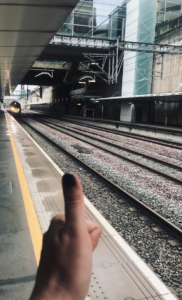London Transport 25
25 different forms of London transport in a day
Hello! My name is Sarah and I love London transport. Because I am a very cool and interesting person, for a long time I’ve thought it might be fun to see how many different types of London transport I can take in a 24-hour period: bus, tram, tube, train, ferry, etc. The trip outlined below took me (and the lucky man I invited on this date) on 25 different forms of London transport in one single day. It criss-crossed the city from East through North to West, then South, Central, South East and back to where we started. I’m sharing the itinerary because this turned out to be a phenomenal adventure, and I thought others might like to give it a go.
Note – this page does not contain adult content and never will (feel free to link to it!), but I’m a sex blogger (that’s literally my job) so be aware that the rest of my website contains erotic stories/images/audio. It’s ethically produced, but not suitable for under 18s. Please don’t click the links in the header bar if you’d rather not see that sort of thing.
London Transport 25: The rules
The rules for the challenge were:
- Transport must be transport, not a ride, i.e. it must take me from A to B. So the London Eye doesn’t count, but the cable car definitely does.
- Each form of transport must continue the journey. So no going from A to B then immediately back again. The journey can meander, but it must keep moving forwards.
- No form of transport can be taken more than once. Changes on a single line are OK (for instance, if traveling on the DLR from Greenwich to Bank requires a change at Canary Wharf, that’s fine, or if you’re on a bus that gets taken out of service you can get on the next one) but repeated trips on the same form of transport aren’t allowed (you can’t take one double-decker bus in the morning then another in the afternoon). The exceptions to this are: walking; escalators; stairs. We’ll be using these a lot.
Feel free to adapt or make up your own rules if you like. I’m not your boss, I just want you to see where I’m coming from.
London Transport 25: The route
Click to jump to each leg of the journey.
- High speed train – Stratford International to St Pancras International
- Thameslink – St Pancras to Farringdon
- Sub-surface tube (Circle line) – Farringdon to Monument
- Moving walkway – Monument to Bank
- Waterloo and City Line – Bank to Waterloo
- Mainline train – Waterloo to St Margarets
- Hammerton’s Ferry – North to south Thames banks
- Single-decker bus – 371 to Norbiton Church
- Double-decker bus – 57 to Wimbledon
- Tram – Wimbledon to West Croydon
- Overground – West Croydon to Whitechapel
- Crossrail – Whitechapel to Liverpool Street
- Inclined lift/funicular – Liverpool Street
- Deep tube (Central Line) – Liverpool Street to St Paul’s
- Hire Bike – St Paul’s to Aldwych
- Vintage Bus – Aldwych to Charing Cross
- Pedicab – Charing Cross to Embankment
- Thames Clipper – Embankment to North Greenwich
- Cable Car – North Greenwich to Royal Docks
- Black Cab – Royal Docks to North Woolwich
- Woolwich Ferry – North terminal to South terminal
- Uber/Private taxi – Woolwich ferry to Cutty Sark
- Lift – Cutty Sark
- Greenwich Foot Tunnel – Cutty Sark to Island Gardens
- Docklands Light Railway (DLR) – Island Gardens to Stratford International
The itinerary…
I tried to take some pictures as I went around, but I’m not much of a photographer and I’m also squeamish about putting photos online that include strangers, which photos of public transport inevitably tend to do, so in some places I’ve used creative commons-licensed images instead of my own so you can see the different types of transport.
I knew I wanted to end the day on the most fun transport in London: driving the Docklands Light Railway. So it had to end somewhere out East and I picked Stratford because it sits at the end of two DLR lines, and therefore would be easy to get to (and, crucially, home from!) even if the day finished late. What’s more, Stratford is a major hub with a wide selection of different transport types, so the day could kick off with the fastest mode of transport on the list…
1. High speed train
Stratford International to St Pancras International
A speeding bullet of a train that gets you from Stratford (Zone 2/3) to St Pancras (Zone 1) in a mere 7 minutes. The same journey on tubes takes well over half an hour, so this magic train feels a bit like teleportation. It costs more than the same journey would if you did it by tube, because special fares apply, but we tapped in just after 9:30 to make it slightly cheaper. And covering so much ground was a kickass start to the challenge.
Distance: 6 miles
Time: 7 minutes
Cost: £8.10 (standard fare), £5.35 (if you have a Network Railcard) OR if you tap in with contactless or Oyster, it’s £4.90 off-peak.
2. Thameslink
St Pancras International to Farringdon
Next up is a train that feels extremely boring even to a big nerd like me, but which serves a really useful purpose, in that it goes all the way through London so if you live in Peterborough and want to get to Brighton without having to sully your trainers with the dirt of the Big City, it’s got you covered. We hopped on it in St Pancras and got off at Farringdon. Points to this train for having in-carriage displays that tell you where the toilets are, and which parts of the train are busy or still have free seats. I imagine this is extremely useful in rush-hour.
Distance: 1.3 miles
Time: 4 minutes
Cost: Included in Oyster cap.
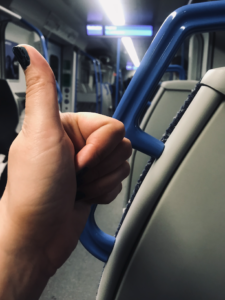
3. Subsurface tube: the Circle line
Farringdon to Monument
Not everyone knows what a sub-surface tube is, and why they are different to ‘deep’ tubes. My date was delighted* when I explained the difference to him, so here are the riveting facts in case you’re also doing the London Transport 25 with someone you wish to impress. The main difference between the two types of London tube line is that sub-surface tubes were constructed using ‘cut and cover’ – workers cut large trenches in the ground, laid the tracks and built the tunnels, then covered them over with earth. By contrast ‘deep’ tubes (which we’ll travel on later) were bored out of the ground using tunnelling methods. As a passenger, the main difference you’ll notice is that sub-surface tubes (District, Circle, Hammersmith & City and Metropolitan Line) tend to have more spacious cars and require fewer steps/escalators to reach them. We hopped on the Circle Line from Farringdon to Monument, and that’s ‘sub-surface tube’ ticked off the list.
*indifferent
Distance: 2 miles
Time: 12 minutes
Cost: Included in Oyster cap.
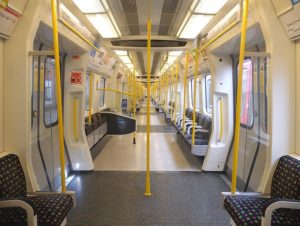
Image via Wikimedia Commons
4. Moving walkway
Monument to Bank
A nice simple one that should delight those of you who care less about trains than about feeling like you’ve got superhuman legs. Follow the signs out of Monument towards Bank, and you’ll eventually get to walk along the moving floor.
Distance: a couple of hundred metres maybe, I didn’t measure it.
Time: 2 minutes.
Cost: Free.
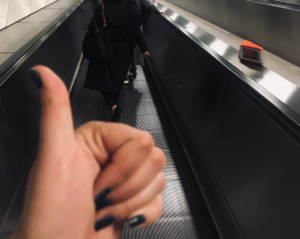
5. Waterloo and City line
Bank to Waterloo
Although it’s technically a ‘deep’ tube, after discussion with other train nerds I agreed that ‘Waterloo and City’ counted as a different form of transport to other deep tube lines because it’s more akin to a shuttle than a train. It only has two stations: Waterloo and Bank (the city). I was initially annoyed about including it because it messed with my planning, but once I’d found a way to weave it into the itinerary I got a bit excited, because it’s a train I’ve only ever taken once or twice. Closed at weekends, usually, because it’s aimed mainly at commuters, the line is also blissfully quiet outside rush hour. Plus, it’s fun to get on a train knowing full well you won’t miss your stop: your stop is the next one. You’re welcome.
Distance: 1 mile
Time: 4 minutes
Cost: Included in Oyster cap.
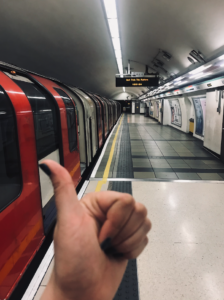
6. Mainline rail (aka. Normal Train)
Waterloo to St Margarets
Not much to say about this: it’s a normal train. Just your common-or-garden, goes-on-the-tracks-in-the-open-air train. But we have to tick it off to maximise different forms of transport, and because we need a way to reach the depths of West London for our next (more exciting) journey. By the time we took this train (about 11 am) it was fairly quiet. At the time of writing, fast trains to St Margarets from Waterloo run roughly once every half hour and you catch them from the weird tacked-on platforms at the end of the concourse – platforms 21-24. If you’ve time, stop off in M&S like we did and pick up canned cocktails and snacks.
Distance: 11 miles
Time: 31 minutes
Cost: Included in Oyster cap.
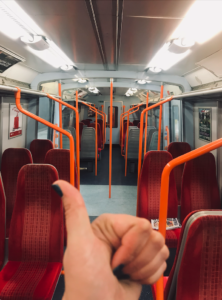
7. Hammerton’s Ferry
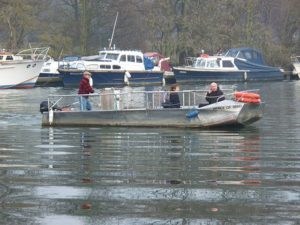
Image via Wikimedia Commons
North side of the Thames to south side of the Thames
The reason we spent half an hour on a normal train was to get to this – one of the cutest forms of transport London has to offer. Hammerton’s Ferry! This is a ferry that’s been in operation since 1908, and it exists purely to take you from one side of the river to the other. The ferry is a short (10-15 minute) walk from St Margarets train station: head to the river, then along the Thames Path. It operates from 10am to 6pm during summer months (March to October). It’s a very small boat, and a very short journey, but there’s something charming about wandering down to a pier on the edge of the Thames and hopping on a boat to be ferried across. When we went, there was a friendly dog on board, which pleased my date as much as the ferry pleased me.
Distance: A hundred metres or so
Time: 1 minute
Cost: £2 per person (you can pay with contactless or cash)
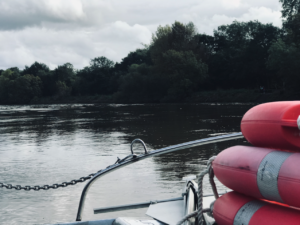
8. Bus (single decker)
Ham House to Norbiton Church (Number 371)
Personally, I think the experience of riding a single decker bus (especially in London) is notably different to riding a double, so we’re doing both on this journey. First up: the 371, which you catch on Sandy Lane just a little way south of where you get off the Ferry (it’s a nice walk through Ham House Gardens to get to the stop). You want the bus that’s headed towards Kingston, and you’re going to get off at Norbiton Church, about 17 minutes later.
Distance: 3 miles
Time: 17 minutes
Cost: Included in Oyster cap.
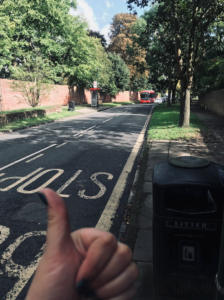
9. Bus (double decker)
Norbiton Church to Wimbledon (Number 57)
Naturally, you get double points for this challenge if you end up driving the bus. By which I mean ‘getting the seat at the front of the top deck, on the right’. My date and I didn’t achieve this, but we resolved to make up for this lack of driving when we reached the DLR portion of the journey later.
When you hop off the 371, cross the road to get the next bus in the direction of Wimbledon. You can take either the number 57 or the 131 which is also a double decker. I know, we’re really spoiled for transport options in London. If you live outside the city and you want to complain about this, know that I am 100% on your side: please feel free to send me any petitions you have to improve transport in your area of the UK and I will share them. I believe everyone should have access to cheap, convenient public transport, that’s partly why I’m so nerdy about it: we should celebrate what we have! And governments should invest in making sure all of us have it!
Distance: 4.5 miles
Time: 29 minutes
Cost: Included in Oyster cap.
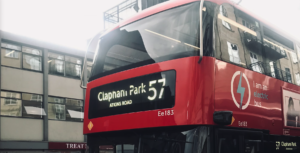
10. Tram
Wimbledon to West Croydon
I wanted a decent stretch on this, because I’d never ridden a London tram before. And I believe it was worth it. My date was disappointed by this form of transport, I think to him it just felt like a glorified train. But the thing that’s magical about trams, to me, is that they span transport genres: one minute they act like a train, chugging along lines that run behind people’s houses and through areas no one can see, the next – BAM! – they’re sharing the road with cars. They’re also articulated, so if you hang around at the join between carriages, the floor moves under your feet when it goes round a corner. Lovely stuff. Hop on the tram at Wimbledon and settle in for a lovely treat.
Distance: 6 miles
Time: 35 minutes
Cost: Included in Oyster cap.
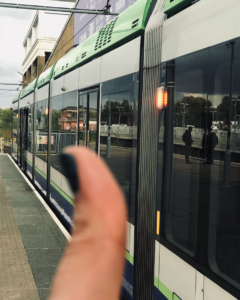
11. Overground
West Croydon to Whitechapel
We got on the overground at about 15:00, but we’d stopped a couple of times for pints along the way, so factor that in if you want to make your own challenge fun instead of a slog. There’s not a lot to say about the Overground other than it’s way better than it used to be. The OG used to be a disparate collection of seemingly random old train lines lumped together under the orange colour – people turned their noses up at it compared to the tube. But these days Overground trains are spacious, clean, reliable and regular PLUS because they’re above ground you get to see parts of the city that you wouldn’t see on a tube. I love the Overground.
The only slight problem is that with so many different lines, it can be confusing to navigate, but TfL are working on that as we speak! New names for each line, with distinct colours on the maps, should make navigation way easier. I’m one of those people who’s excited for the new maps and signage now that each Overground line has officially been named.** If you’re interested, this one that carried us from West Croydon to Whitechapel will soon be known as The Windrush Line.
**some of the names themselves are pretty rubbish though. The ‘Lioness’ line? Meh.
Distance: 11.5 miles
Time: 35 minutes
Cost: Included in Oyster cap.
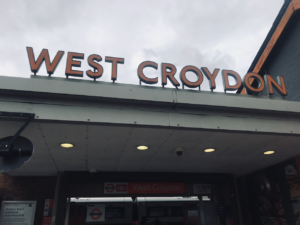
12. Crossrail
Whitechapel to Liverpool Street
I refuse to call it the ‘Elizabeth Line’ unless I’m directing tourists: to me it will always be Crossrail. My best, most beloved, favourite train line ever. Did you know that when they constructed Crossrail they lay special ‘floating’ sleepers to minimise noise levels under the Barbican so as not to disturb performances? Did you know that during excavation they had to cover Soho with sensors that constantly monitored movement so as to prevent the whole thing from collapsing? I went to a meeting near Soho square, during Crossrail construction, and the foundations of the building we met in had shifted so much that the room was incredibly tilted – when I put my coffee cup down on the table, half the coffee spilled out. The meeting people assured me it was safe, because of these sensors, so I just got to marvel at how thrilling and clever the whole thing was. Oh! And did you know that when they bored the hole for Crossrail through Tottenham Court Road station they did it with less than a metre’s clearance above and below the machine, while the station was still in use? You should watch the BBC documentary if you can get hold of it. Or don’t. As mentioned before, I’m not your boss.
I am a fan of Crossrail though, and it definitely counts as a different form of transport because the trains are sleek and fast, and the stations feel incredibly futuristic. Crossrail is bigger, faster, better, cooler than any other transport in the city and I still get a thrill when I ride it.
Distance: 1 mile
Time: 3 minutes
Cost: Included in Oyster cap.
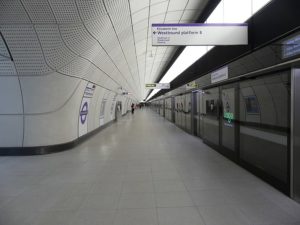
Image via Wikimedia Commons
13. Inclined lift (funicular railway!)
At Liverpool Street Station, as you come up from the Crossrail platform towards the other trains, you can go in a very special lift (or ‘elevator’ for our American pals). It’s made of glass so you can see out, it runs directly next to the escalators, and it goes upwards diagonally along the same path. This excited me no end when it first came out and although I would never get on it if there were people with wheelchairs/heavy suitcases/buggies waiting (don’t be a dick), if you hang around for long enough you too can step into a glass box that whisks you up to the next level while you wave at the suckers on the boring old escalators. It’s basically like a miniature funicular railway, which meant that my date got to comment that we were ‘putting the ‘fun’ in ‘funicular’. He’d be gutted if I didn’t mention this joke. Besides, I imagine that the sort of massive nerd who’d read this far down the page will appreciate a good railway pun, so you’re welcome.
Distance: some metres.
Time: 1 minute
Cost: Free.
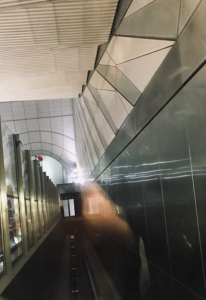
14. Deep tube: Central line
Liverpool Street to St Paul’s
This is what most people picture when they think of the tube: hot, cramped, and full of commuters. Yay the Central Line! Simultaneously one of the best (because it goes to good places) and the worst (because it’s too often boiling and full) tube line in London. I tried to keep it short: a mere two stops before we hopped off in search of the next form of transport.
Distance: 1 mile
Time: 6 minutes
Cost: Included in Oyster cap.
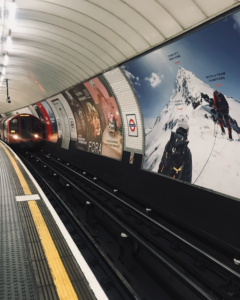
15. Hire bike (AKA Santander bike)
I absolutely love the TfL hire bikes (currently Santander bikes, but who knows what the sponsor name will be in future). Not only are they brilliant fun for travelling, but the fact that anyone can use them has (in my opinion) given London drivers a much-needed dose of extra awareness for cyclists (still not enough though, please ride carefully! More importantly drive carefully if you’re in a car/truck!).
I ride my own bike in the city quite a lot, and I welcome even the wobbliest of tourists. Join in! Have fun! Try out some of the many new cycle paths that have sprung up in the last five years! When I moved to London I swore I would never ever cycle in it: a dangerous, frightening, horrible experience for sure. But that was over 15 years ago and times have changed a LOT. If you just want to try these out, check the Santander map for your nearest docking station – I recommend a turn around Hyde Park if you just want to practice, or for great views try a trip eastbound from Westminster along the wide, smooth cycle path on the north bank of the Thames. You get one ride of up to 30 minutes for £1.65 or a day pass for £3, and to my mind it’s a gorgeous way to see this lovely city.
Thus far, my date has been great company and game for joining in, but at best I’d say he was ‘affably tolerant’ of the London Transport 25 challenge. When we get on our bikes, however, he starts to exhibit a genuine, childlike joy. We speed through central London from St Paul’s towards Aldwych, and as we slip them back into the docking station, both of us lament the fact that we didn’t pick a longer journey for the ‘bike’ portion of the day.
Distance: 1 mile
Time: 5 minutes
Cost: £1.65 per person
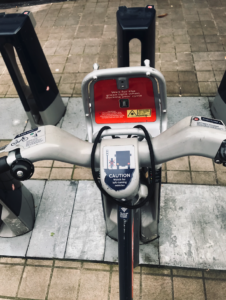
16. Bus (vintage)
Aldwych to Charing Cross
I’m a big fan of vintage buses, so the heritage T15 route had to be included in the challenge. It’s an old Routemaster that runs the same route as the (normal, modern) 15 bus, between Tower Gateway and Charing Cross (occasionally going as far as Waterloo). You can see their weekday timetable here, and their weekend one here. Note that the weekday service stops between 5-6pm, so if you’re doing this route in a day like we did you’ll need to make sure you hit Aldwych (the Royal Courts of Justice bus stop, heading Westbound) before 5pm. And if you do it in rush hour, be prepared for the fact that your bus might be incredibly late. We waited over half an hour for ours, and almost gave up on including it. Luckily just as we almost lost hope, it trundled round the corner causing squeals of delight (me) and sighs of relief (him). Having explained to the baffled conductor that yes, we were only planning on going a few stops and no, we didn’t mind paying £2.50 for a trip of less than half a mile, we tapped our cards and settled in on the top deck for a nanosecond.
Distance: Half a mile
Time: 8 minutes
Cost: £2.50 (this isn’t included on Oyster)
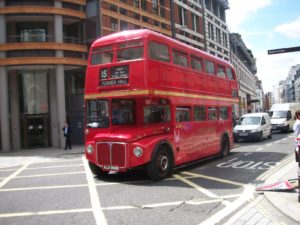
Image via Wikimedia Commons
17. Pedicab
Charing Cross to Embankment
This leg of the journey represented our biggest challenge. As Londoners, there’s a deep and powerful shame in being seen taking such a touristy (and excruciatingly expensive) form of transport as the pedicab. But you can’t really embark on a challenge then give up when part of it’s hard, and ‘pedicab’ fell well within my rules so we swallowed our pride, opened our wallets, and wandered up The Strand until we spotted a man with a cycle rickshaw blaring twee elevator-versions of pop songs.
Not being a tourist, I had deliberately chosen ‘Charing Cross to Embankment’ for the pedicab portion of the journey because it’s notoriously one of the shortest journeys you can take in London (it is far quicker to walk than it is to go down into the tunnels and hop on a tube – someone pointed out that the shortest is actually Leicester Square/Covent Garden, so I’ve corrected this). And yet, this pedicab fare was more expensive than any of the other journeys we took on that day. Not just ‘more expensive per mile’, but ‘more expensive’ full stop. What’s more, our rider had a very laissez-faire attitude towards cycle safety which struck horror into my heart: mounting the pavement, weaving out in front of taxis, and honking his horn any time he felt like it (mostly in time to the music). Having said all that we actually both agreed that the weirdness made this leg of the journey quite fun. Please don’t tell my London friends.
Distance: Half a mile
Time: 6 minutes
Cost: £20 – TWENTY ACTUAL POUNDS
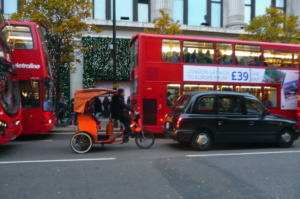
Image CC licensed via mwanasimba on Flickr because I didn’t want to give you an actual picture of our rider. This is not our actual rider, or the actual pedicab, but you get the idea
18. Thames Clipper (AKA the Uber Boat)
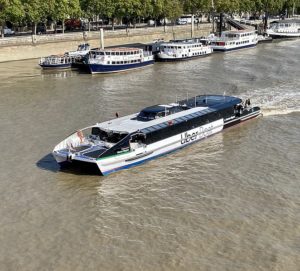
Image via Wikimedia Commons
Embankment to North Greenwich
Get ready to be wowed because the Thames Clipper absolutely rocks. Also currently known as the “Uber Boat”, the Thames Clipper is our second boat of the day, but the first one to sail directly into my heart. This is a truly beautiful ride and I don’t mean that in a transport nerd way like when I told you trams were ‘magical’ or that my facts about sub-surface versus deep tube were ‘riveting.’ I mean normal people will definitely think this rocks too: it’s a truly gorgeous, exciting way to see London. It’s also accessible in ways other forms of transport in our creaking old city are not – ramps are available at all piers and staff will help you board. Once you’re on the boat, there’s an indoor section with huge windows for amazing views, big comfy seats, lots of space (and toilets), not to mention a BAR that sells drinks and snacks. Best of all, in my opinion, is the back of the boat which has a section in the open air so you can feel the wind in your hair.
We grinned, we giggled, we pointed out our favourite riverside pubs as we sped past… we even got to take the photo below of a big red bus crossing Tower Bridge – the most London picture I’ve ever taken in my life. Even if you never do the London Transport 25 challenge itself, please treat yourself to a ride on the Clipper – it’s glorious.
This particular journey is on a boat labelled RB2 – info and timetables on the Thames Clipper site.
Distance: 9 miles
Time: 47 minutes
Cost: £10.25
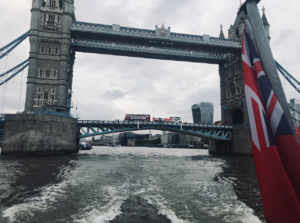
19. Cable car (AKA IFS Cloud, Dangleway)
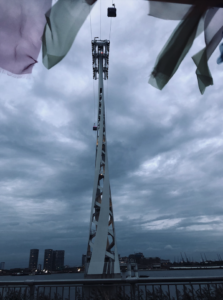
North Greenwich to Royal Docks
If you’re playing along with this journey, and you thought the Thames Clipper was a romantic and cool mode of transport, then just wait till you see what’s coming next: the cable car! It’s currently known as the IFS Cloud, was previously known as the Emirates Airline and I’m sure will be known as something else when the sponsor changes in future. Unusually for a London transport nerd, I’d not actually been on the cable car before. Something about it seemed too touristy. Too busy. Too cheesy. Too much like the London Eye, perhaps? How wrong I was!
The cable car is open from 7am to 9pm on weekdays (11pm on Friday), from 8-11 on Saturdays and on Sundays it opens at 9am and closes at 9pm. Each pod carries up to 10 people, it’s accessible to most wheelchairs and is bike-friendly too, if you’re cycling and want to continue your journey on the other side of the river. In fact, the cable car is apparently free to people with bikes before 9:30 am, what a world. But the most important thing you need to know about the cable car – the thing that made all the difference to me – is that they let you have your own pod. I don’t know if this is true during rush hour or at other busy times, but at 8pm on a weeknight when the sun had gone down and the sky promised romantic views of London, it was certainly true for us. Each group, be they six, four, a couple or even solo travellers… all got their own private pod.
Read more about our nighttime ride on the cable car over on my actual blog where, I can’t stress this enough, you will also find adult content. Be aware before clicking.
We did not [adult content] on the cable car, cos that’s illegal, but I’d be lying if I said we weren’t tempted. It was so romantic: night time views across the city! A still, quiet evening! Holding hands together as we were whisked off into the sky! If that weren’t already badass enough, as our pod started descending we experienced a little turbulence, the cable car stopped temporarily, and to my utter enraptured delight we got to watch a plane land at London City Airport! Pinch me!
Distance: How many miles from here to heaven? Nobody knows.
Time: Not long enough (10 minutes)
Cost: £6
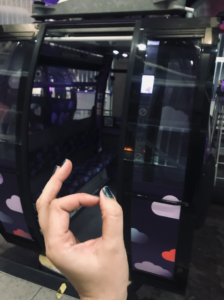
20. Black cab
Royal Docks to North Woolwich
Second only to the red double-decker as far as iconic modes of London transport go, but usually pretty pricey, so I didn’t want to use one for a long stretch of the journey. I took a gamble that there’d be black cabs waiting at the Royal Docks to pick up tourists who’d just been on the cable car… and I was right! We flagged one down, prayed for our wallets, and headed to our next destination.
Distance: 2.7 miles
Time: 10 minutes
Cost: £16.20
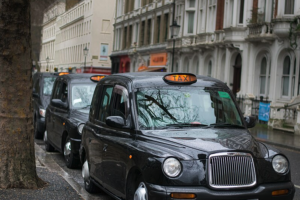
Image via Wikimedia Commons
21. Woolwich ferry
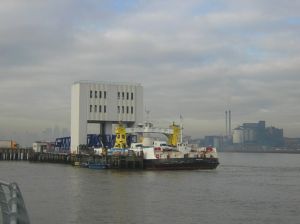
Image via Wikimedia Commons
A surprise hit, this one. The Woolwich Ferry is a service that runs from North Woolwich (a ferry terminal just south of London City Airport) to actual Woolwich, south of the river. It runs every 15 minutes, is open to all – cars, bikes, pedestrians, etc. You just drive onto it, or walk as we did, then when it’s time they close the barriers and the ferry you’re on heads across the river while its counterpart returns in the other direction. The fact that it is also completely free means this is essentially a boat that performs the service of a bridge. No one checks tickets or makes you tap your card. Just walk on, float across, get off.
There’s a really beautiful moment where our boat passes the other identical one in the middle of the river. I look out across the Thames through the inky night to our counterparts on the deck of that Other Woolwich Ferry. Wondering if they’re doing their own London Transport 25 challenge, because they’re also very cool and interesting like me. Maybe I can try this same thing again in the other direction one day? I might, you know, it’s been brilliant. And the Woolwich Ferry is one of my highlights. It’s industrial and practical, not designed for tourist use. And yet, I think it’s worth a jaunt if you find yourself in that part of town. There’s a foot tunnel that covers the same route, so you can ferry across and then walk back if you fancy it.
Distance: 0.4 miles
Time: 5 minutes
Cost: FREE
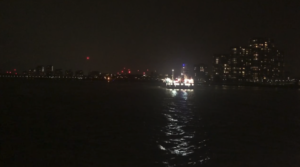
My own picture of the Other Woolwich Ferry. According to my date it was not ‘just like in that film Coherence.’
22. Private hire cab/Uber
Woolwich to Cutty Sark
I didn’t really want to include this, but I figured it’s such a ubiquitous mode of transport it’d be strange to leave it out. Besides, it was nice to have this in my back pocket as a way to link the Woolwich Ferry to the final leg of the journey without having to double up on mainline trains. Our driver was nice, the journey was quick, and that’s all I have to say about that.
Distance: 3.5 miles
Time: 20 minutes
Cost: £10.98
23. Lift
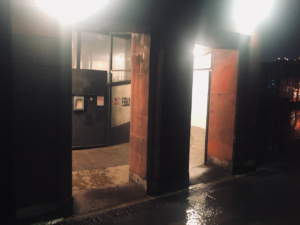
Cutty Sark (street level) to deep below the water
Yeah, we’re counting this. The lifts that take you down to the foot tunnels under the Thames are A Bit Special and Good, so I’m including one vertical lift journey as a form of transport. They’re huge, old-fashioned, wood-panelled things and if you’re a nerd like me you should give them a go when you’re visiting (info on which lifts are in service can be found here).
The lift down to the foot tunnel definitely abides by rules 1 and 2 of my London Transport 25 (must take you from A to B and continue the journey), but unfortunately, transport rule number 3 (you can’t take the same mode of transport more than once) meant we couldn’t then take the lift back up at the other end – we had to climb the stairs instead. Hat tip to my date for noticing this in time. While I was climbing the 87 steps back up at the other end of the tunnel, I confess to being slightly annoyed that he’d pointed it out but once we reached the top, I thanked him: I made the rules myself, it would truly embarrassing to break them by accident.
Distance: 15 metres
Time: 20 seconds
Cost: FREE
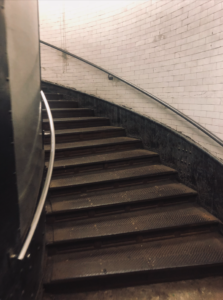
24. Greenwich foot tunnel
Cutty Sark to Island Gardens
There’s not much to say about the foot tunnel other than that it’s a lovely little stroll. And you’re deep beneath the Thames which I find quite exciting. Disappointingly, the walls of the tunnel are not made of glass so you can’t see all the fish and old bike tyres and whatnot (when I was a child I genuinely used to believe this was how all underwater tunnels, including the Channel Tunnel, were constructed. Imagine my disappointment), but it’s still quite fun to walk through. The Greenwich foot tunnel is marginally more exciting than the Woolwich one because it has a section which was damaged by bombs during the second world war and has since been repaired with thick steel panels.
Distance: 370 metres
Time: 10 minutes
Cost: FREE
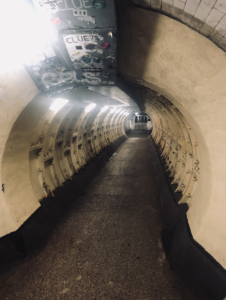
25. Docklands Light Railway (DLR)
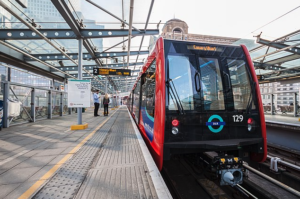
Image via Wikimedia Commons
Island Gardens to Stratford/Stratford International
As I said at the start, my favourite form of London transport is the DLR because if you time it right and you’re quick off the mark, you can sit in the front carriage and pretend to drive it. This pastime is so popular that Transport for London recently added sticker panels to the front of some carriages with buttons like ‘Mind the Gap’ and ‘Bow Church Bells’. In my opinion, these buttons are a great idea but simply not good enough: I want actual pressable buttons when I pretend to drive the train, and none of this ‘Mind the Gap’ nonsense. ‘Mind the gap’ is an announcement mainly used on the underground (both deep and sub-surface tubes), and only rarely on the DLR, which does not have the same kind of gap hazard at most stations. In fact, my research tells me that only 6-8 DLR stations have gaps with a ‘B’ rating and therefore require a ‘mind the gap’ announcement. You’re right – I AM fun at parties.
I digress. Buttons or no buttons, it’s still a genuine thrill when you manage to get the driver’s seat on the DLR, and our chances to do this were high because by this point it was close to 10pm, so we didn’t have to worry about deferring to children (as I always begrudgingly do, if they want to drive the train). What’s more, completing the loop to Stratford International meant we had to change trains halfway, so we had a double shot at getting the driver’s seat.
As we successfully did. I’m no amateur.
Distance: 5 miles
Time: 27 minutes
Cost: Included in Oyster cap.
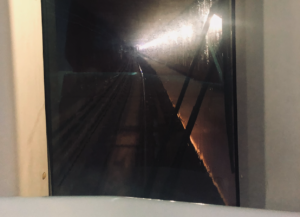
London Transport 25: how much did it cost? And how far did we go?
The thing I was most curious about was what all this gallivanting would do to our contactless cap. TfL caps the amount of money it will take from your contactless or Oyster card in a day, and contrary to popular belief this is NOT more expensive than buying a travelcard. It’s actually cheaper. For instance, a day travelcard from zones 1-4 (the furthest we got was St Margaret’s, which is a zone 4 station) would cost £15.90, but the contactless cap is only £12.30.
However, some of the forms of transport for which we tapped our contactless cards – although billed as ‘TfL travel’ on my credit card, weren’t included in the cap, for example: high speed rail, Thames Clipper and the cable car. Here’s a breakdown of our total costs (per person):
Contactless cap: £35.75 (this is a combination of many different forms of transport all lumped into one sum)
Uber: £5.49 [full fare was £10.98]
Black cab: £8.10 [full fare £16.20]
Pedicab: £10 [full fare TWENTY WHOLE ACTUAL POUNDS]
Hire bikes: £1.65
Vintage bus: £2.50
Total = £63.49 per person.
I also found a random charge on my card: £6.70 – This registered separately to the costs above, and I have a feeling this is the TfL off peak maximum fare, it gets charged when you tap in somewhere but forget to tap out (or tap out without tapping in). I’m not counting it, because it’ll be the result of me making a mistake I think. Perhaps I am an amateur after all (sadface). If this ever happens to you, by the way, you can claim back the money on the TfL website.
We covered over 70 miles in total – 71.9 plus the extra bits and pieces for tunnels, walkways and short hops. The furthest stations:
North – St Pancras International
South – West Croydon
East – Woolwich
West – St Margaret’s
Which types of transport are missing from this trip?
It’s OK, I know I missed some. Initially I set out to include every possible different type of transport, but I ran into a few barriers. Some were practical, like cost or ability-to-drive and others were personal, like I looked at certain things and just thought ‘nah.’ I wanted this to be challenging but fun, so while I know there’ll be people desperately wanting to comment and let me know I did it wrong, in fact I think you’ll find that both I and my date had a fabulous time so I did it perfectly.
If you’d like to expand the challenge, though, here are a few more modes of transport you could add:
- Water ‘bus’. This is a touristy boat ride you can take from Paddington basin through Little Venice and down to Camden Market (or the other way round). I didn’t include this on the list because at £17 per person, it was just too much for me to justify. I’m a writer so I’m professionally broke, and this was already an extravagant day.
- E-scooters. You can get Lime or Voi scooters in various places across the city, download the apps for more info. I’m sorry to not include these, I have terrible balance so I hate and fear them. I didn’t want to include them because I’d have dreaded the day, but if you’re braver than me then have at it.
- Forest/Lime/other e-bikes. I felt I’d covered off ‘bikes’ with the Santander ones, but if I were to do this again, e-bikes would be the first thing I’d add to the list. Next would be…
- PedalMe bike taxi. These people are better known for being couriers, but they do also offer a taxi service and it looks pretty fun.
- Normal bike. I did almost include this, and if I’m truly honest with you I’m kicking myself for not doing so. I even have a spare bike which I prepped and pumped the tyres on so my date could cycle with me! But I ditched the idea at the last minute – he doesn’t have a helmet and it had been pouring with rain so the roads were very slippery. I’d have kicked myself forever if the London Transport day of my dreams began with the man I love suffering serious head injury. What’s more, we wanted to stop off for pints and we couldn’t have done that if we’d had to cycle home again. If you have a bike of your own, though, and you don’t tend to drink as much as we do, I think a normal pushbike is different enough to a Santander tank to count as another form of transport: add to your tally, treat yourself!
- Zipcar. I don’t drive. GREAT addition if you do though, but only if they let you drop it off at a different location to where you pick it up: must continue the journey, remember?
- Motorbike taxi. Did you know you can hire someone on a motorbike to ride you through London? I did not! But someone mentioned it when I was researching this, so I added it to my list. Then immediately crossed it off my list because it scared me.
Hat tip to a few other great suggestions that didn’t fit the rules, but which I think are well worth trying some day: the London Eye, of course, taking a lift up to the top of the Sky Building, stairs to the top of the Monument, the pedal go-karts or even Segways in Battersea Park.
London Transport 25: Final thoughts
I was initially worried that this day would consist of me dragging my date around the city as he grew increasingly bored, and if that’s how it had turned out you wouldn’t be reading this now. We had an incredible time though: stopping for pints just before Hammerton’s Ferry, then for snacks/drinks at a few other points along the route. If you want recommendations, we liked The White Swan in Twickenham which has a lovely little riverside garden. It was also well worth taking a break at North Greenwich, drinking cans and eating snacks while the sun set over the Thames, so our trip on the cable car could be timed perfectly to see the London skyline at night. This route isn’t just great for taking in lots of different forms of transport in a day, it also builds so that some of the most exciting and romantic trips are taken in the evening.
I’m very grateful to him for coming along even though he’s not a nerd for buses like I am. His honest take: he was a little disappointed by the tram, but his highlights were the Santander bikes (for fun, whizzy joy), the Thames Clipper (for overall brilliance) and the cable car (for pure romance). Plus, I think the fact that we’d travelled on so many different forms of transport earlier meant the excellence of these could be appreciated even more.
Did you enjoy this?
If you liked reading this, or had fun trying it for yourself, I would massively appreciate any of the following:
- Shares of this page: please don’t copy and paste any bits, but feel free to share the link anywhere you like.
- Nice messages/comments telling me about your own journey if you decide to do it (I’m @GirlOnTheNet on Twitter, BlueSky and Mastodon – be aware I sometimes post adult content on these channels).
- Similar routes in other cities: how many different types of transport can you go on in Paris? New York? Osaka? That’d be super cool.
- Links back to this page if you want to show other people. As I say, the rest of this site is adult but this page won’t ever include saucy images, audio or text.
